The last few years have been something of a roller coaster for S.K. Beveren. After nine straight seasons in the top flight of Belgian football, the club were relegated from the Belgian First Division A to the formerly named 1B Pro League at the end of the 2020/21 season after losing to RFC Seraing in the promotion/relegation playoff. The club likely would have been relegated the season prior, as they sat bottom of the table before the league was cancelled due to the COVID-19 pandemic. However, they managed to stay in the top flight after legal proceedings that ruled they should not be relegated.
Last season, the club did well in the second division but only managed to finish in third place, meaning they would be out of the top flight for a second consecutive season This spelt the end of Jordi Condom’s time as manager, with him transitioning to the club’s technical director. The club then turned to former Gent and Deinze boss Wim de Decker to manage the club for this upcoming season, with the club currently sitting top of the Challenger Pro League after 13 match days. This tactical analysis and scout report will take an in-depth look at the tactics the Belgian manager has implemented, and look at why they have been so successful so far this season.
Formational setup
So far this season, Wim de Decker has opted to line his side up in a 3-4-1-2 formation, with him looking to play a possession-oriented brand of football. The graphic below highlights this tendency to stick with a three-at-the-back system, but it interestingly also illustrates the 4-2-3-1 as the second most played system that Wim de Decker has used this season.
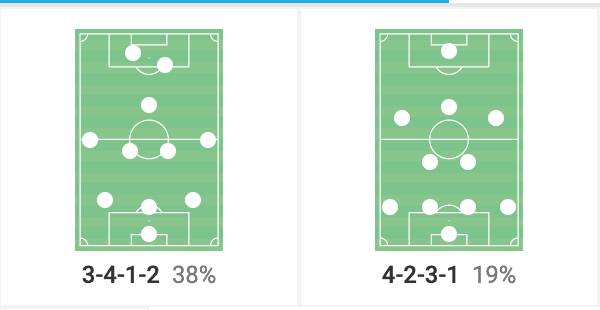
This is because, at the beginning of the Challenger Pro League season, the Belgian manager normally did play a 4-2-3-1, before opting for a more expansive 3-4-1-2 after the first few matches of the season. The switch to this formation has definitely paid dividends, with the club winning 6 of their last 7 since the full-time switch to a 3-4-1-2.
Build up play
Under Wim de Decker, S.K. Beveren have been a possession-oriented side this season, with the Challenger Pro League side averaging just under 428 passes per 90 minutes. They also are averaging 52.8% possession per match as well, continuing to illustrate their possession-based principles in build-up play.
Another thing to emphasise when it comes to Beveren’s build-up play is the role of the centre-backs and wide channels to progress play forward. The pass map below from the Belgian side’s most recent match (at the time of writing) shows this trend in more detail.
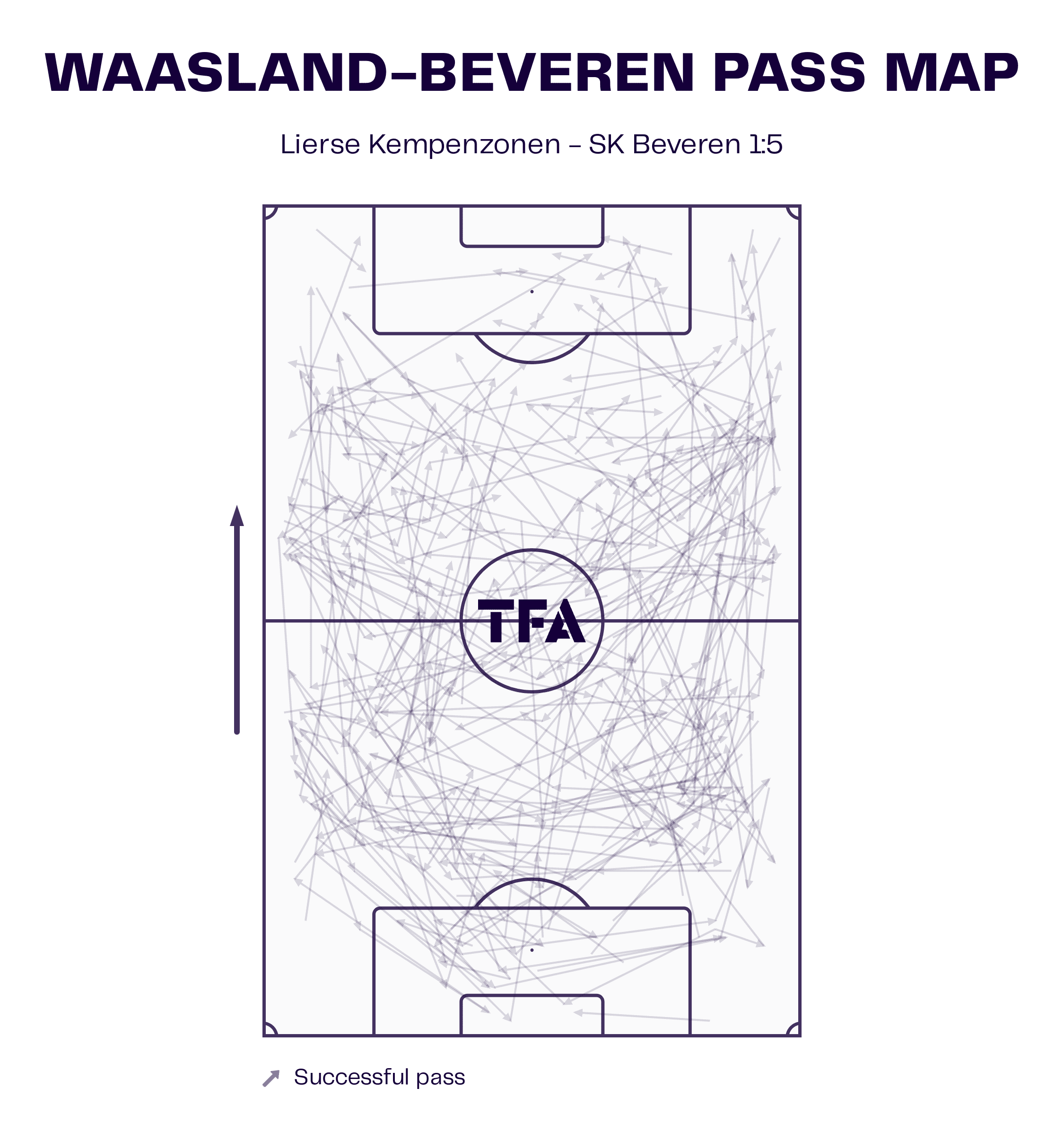
As is shown by the successful passes from Beveren’s last match against Lierse, most of these completed passes occurred between the central defenders and into the wing-backs in the wide channels, with the centre of the pitch seeing fewer completed passes, especially when they progressed into the attacking half and the final third.
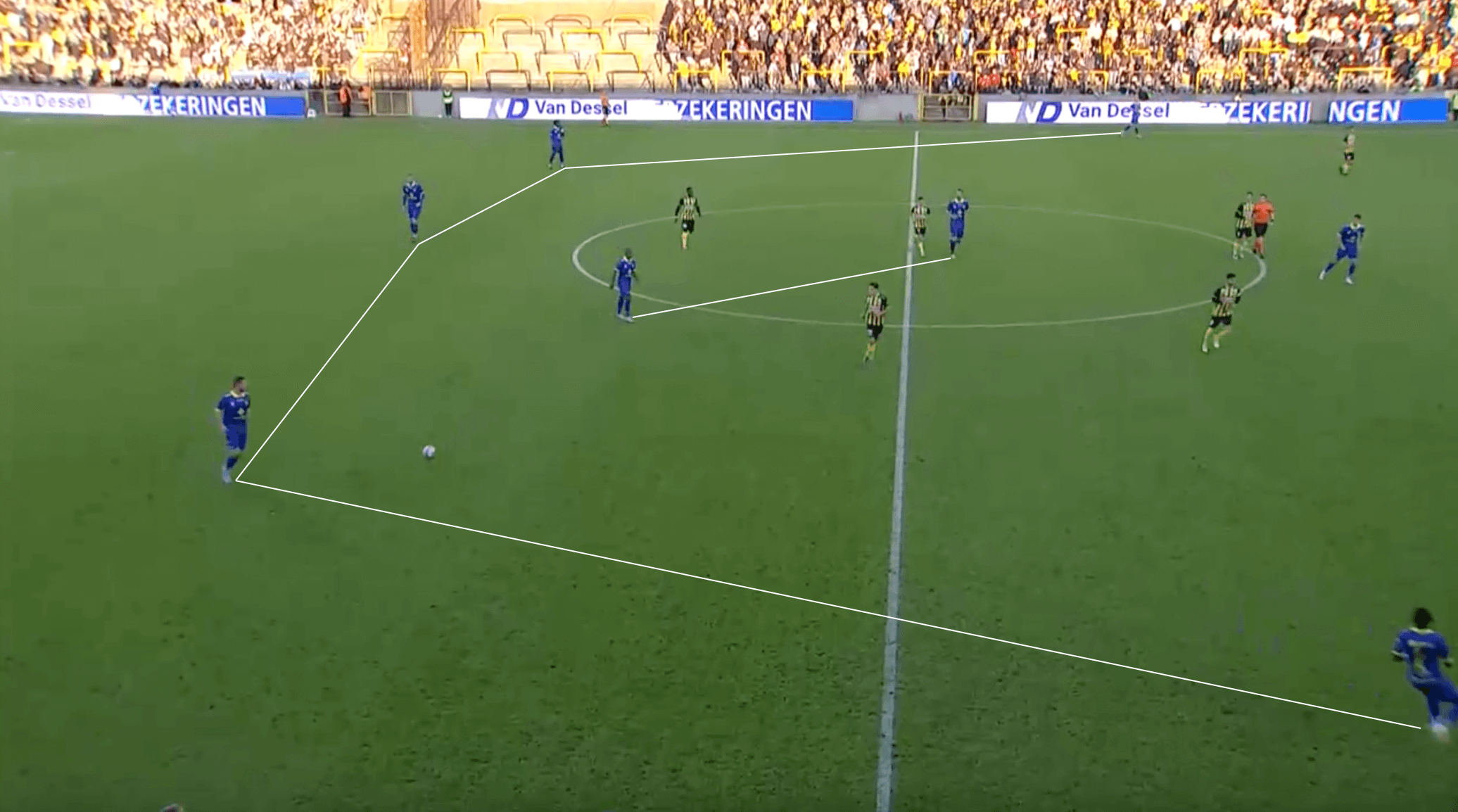
The image above from S.K. Beveren’s most recent match against Lierse shows this build-up shape that the Belgian side opt to start attacks out of. As we can see, the three centre-backs drive the build-up phase, with all the play starting with them. The wing-backs are positioned high and are out on the touchlines, allowing them to keep the attacking width. In the central areas, the two deeper-lying midfielders stay connected to help facilitate the build-up phase of play.
Further forward, the central attacking midfielder and the two forwards work to interchange positions and open up passing lanes, with them normally drifting into wider positions to receive possession. The wing-backs will also look to make overlapping runs past the forwards out wide, allowing them space to send crosses into the box to the onrushing midfielders and forwards already positioned inside the penalty area. This is illustrated by S.K. Beveren playing the second most crosses of any side in the Challenger Pro League so far this season.
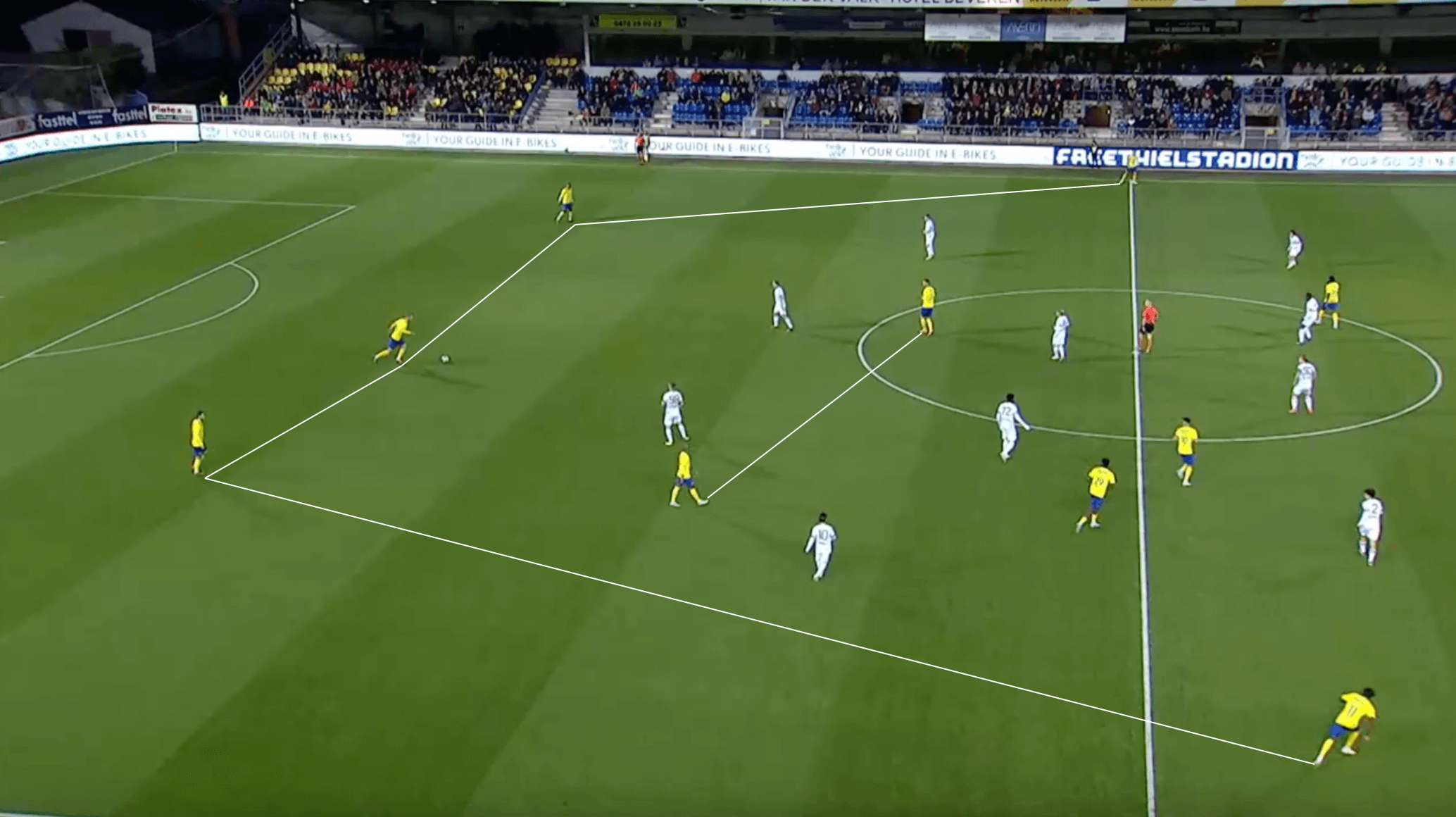
The image above again shows a good example of the shape that S.K. Beveren during build-up phases of play. The three centre-backs again stay in a relatively straight line, with the two wing-backs moving into much higher positions, as well as hugging the touchline to keep the width. The two more defensive-minded midfielders again stay much deeper, which opens up the space out wide for the wing backs to run into.
In this specific phase of build-up play for Beveren, the central centre-back of the three can play a long ball into the wide channel for the wing-back on the near side to run onto. With Beveren keeping all those bodies in a central position, it forces the opposition to stay more narrow, allowing these long ball opportunities to open up out in the wide channels.
Though Wim de Decker’s side are more possession-based, their style of build-up play is rather flexible, with Beveren having the capability to either go long or use a more patient style of build-up play depending on the situation. However, when looking at the next section, we can see that a quicker style is the preference in most situations.
Quick, incisive passing in the final third and crossing from wide areas
When looking at the attacking side of the game for Wim de Decker’s Beveren side, one tactic that stands out is the quick and incisive passing that occurs when his side reaches the final third. Though statistically, Wim de Decker’s side hold more possession on average than their opposition, they do not attempt many passes per sequence of possession.
This does not necessarily mean that Beveren are a side that look to play route one football and get the ball into the final third as quickly as possible, but rather, they look to attack quickly, playing one-touch passes to try and keep the opposition defenders on the back foot at all times.
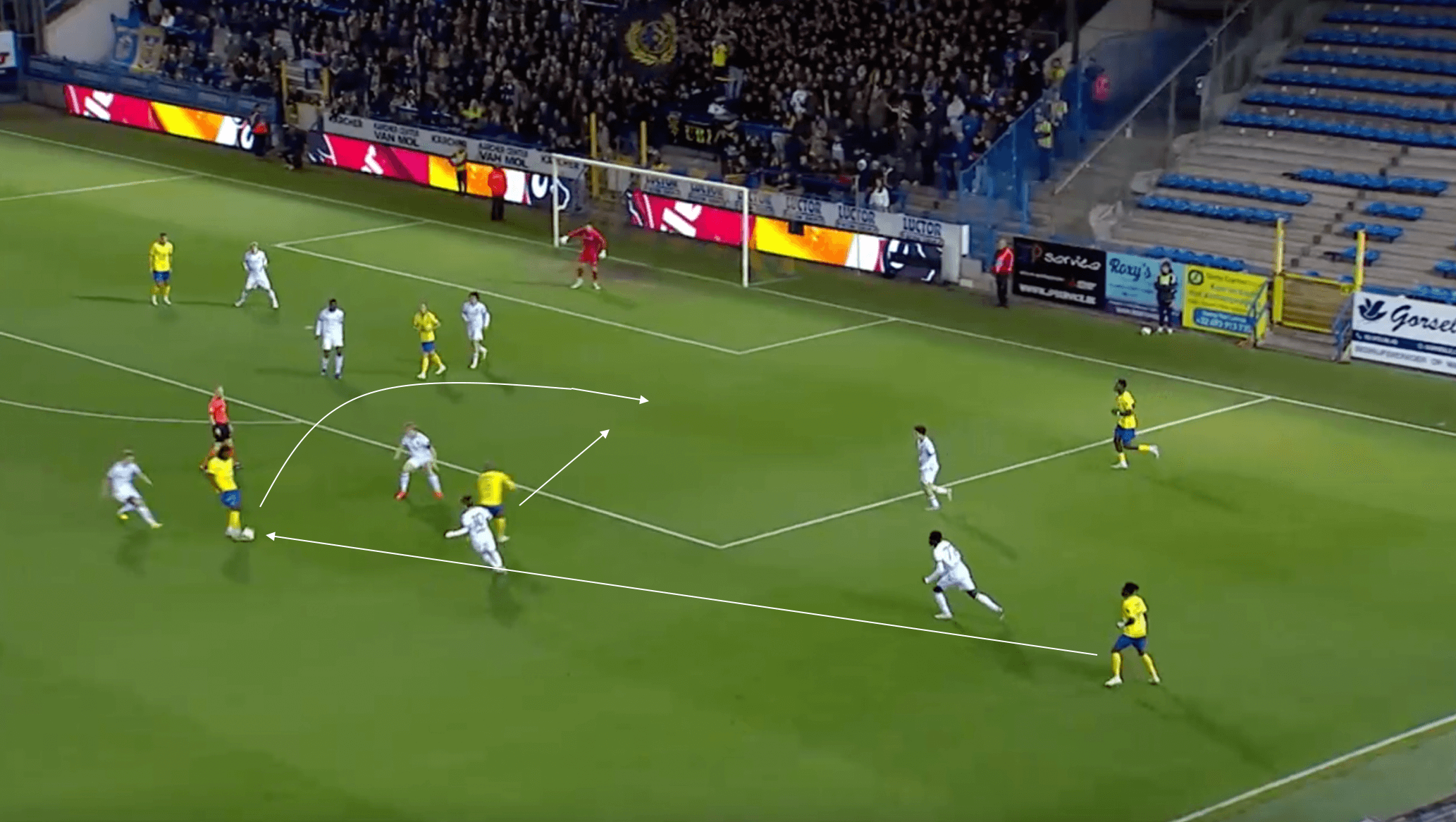
The image above shows an example of this quick and incisive movement, along with one-touch passing, that looks to be utilised by Beveren in the final third. In this phase of play against Club Brugge II, the ball was initially played all the way out wide to the forward in the most advanced position. He played his pass back to the wing-back on the near side, who played a one-touch pass to the midfielder on the edge of the penalty area.
As we can see from the image, the midfielder is instantly closed down by three opposition defenders, but the other defenders are not able to get into position quickly enough as a result of the one-touch incisive passing that occurs. With the majority of defenders either on the back foot or caught ball watching, the Beveren player can play a looping first-time ball over the top of the defence and into the path of the runner. The Beveren player can take a first-time shot that the goalkeeper has to parry, with the ensuing shot falling to the forward who has made a run into the 6-yard box. This results in a goal for Beveren, with a lot of this being down to the quick and incisive passing in the final third.
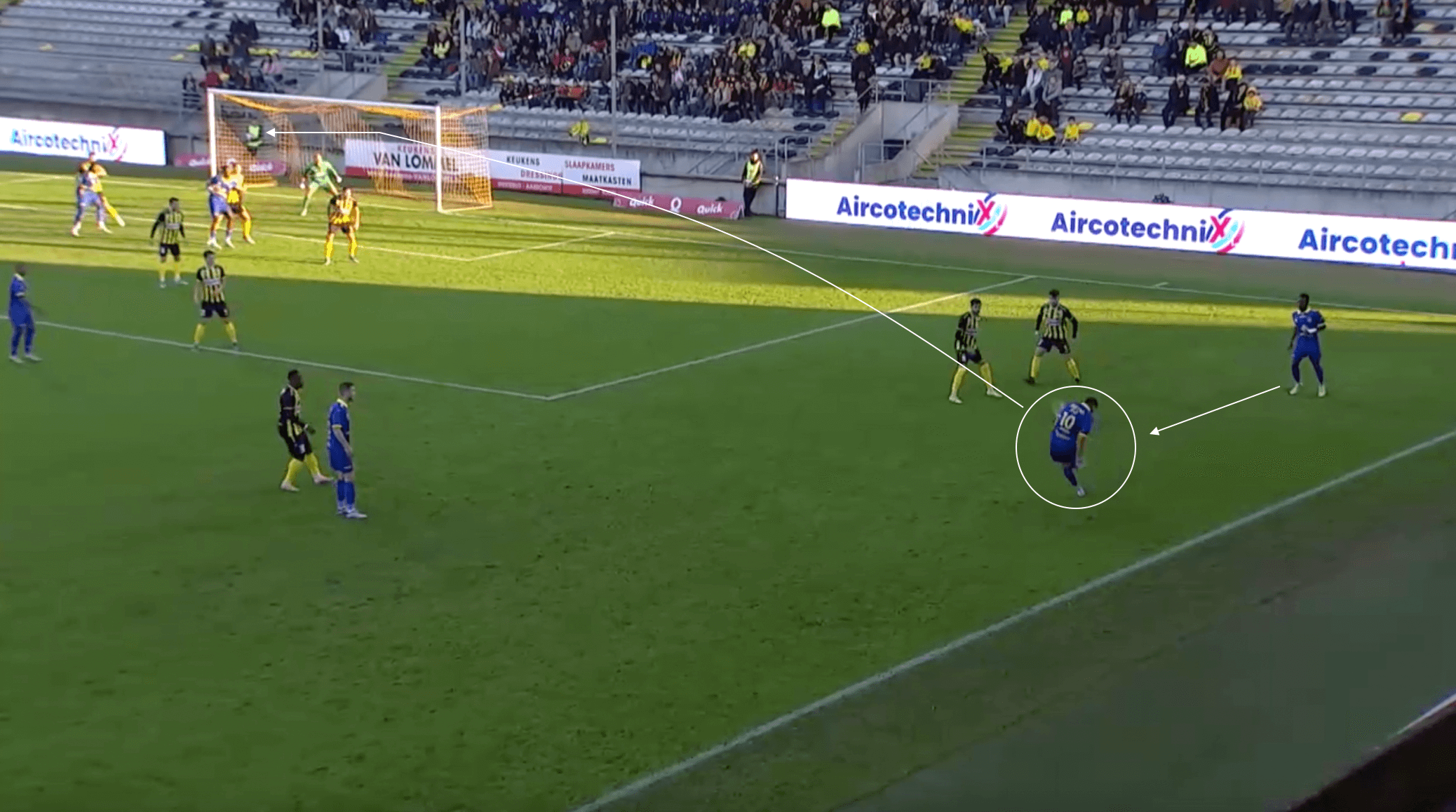
As mentioned earlier in this tactical analysis, S.K. Beveren have attempted the second most crosses in the Challenger Pro League so far this season, only trailing Beerschot. While not all of these crosses have reached their intended targets, sending crosses into the penalty box can cause chaos for opposition defences, and the phase of play above demonstrates a good example of this.
The Beveren midfielder has drifted into this wide position on the near touchline to support the wing-back, who found himself in a 2v1 situation. The midfielder can play a first-touch cross into the box, which the goalkeeper has to come out to punch away from danger. However, the punch is poor, allowing the second-ball players for Beveren who are positioned in the box to get another chance. After a little bit of a scramble, the ball is eventually cleared away by the Lierse defence, but not before Beveren gets a couple more shots on target. Though the cross did not reach its intended target, it still was able to cause chaos inside the box for the opposition.
Strategic high-pressing style
The final tactic that this piece will look at is the strategic high-pressing style that Wim de Decker has brought to Beveren. So far this season, the Challenger Pro League side have the second-highest PPDA, with their roughly 9 PPDA trailing only Beerschot in the second division so far. The Belgian side will look to press the opposition’s back line with the forwards, hoping to win possession in advanced areas of the pitch. However, the top of the table side will not always press, rather, they will wait until the opportunity arises.
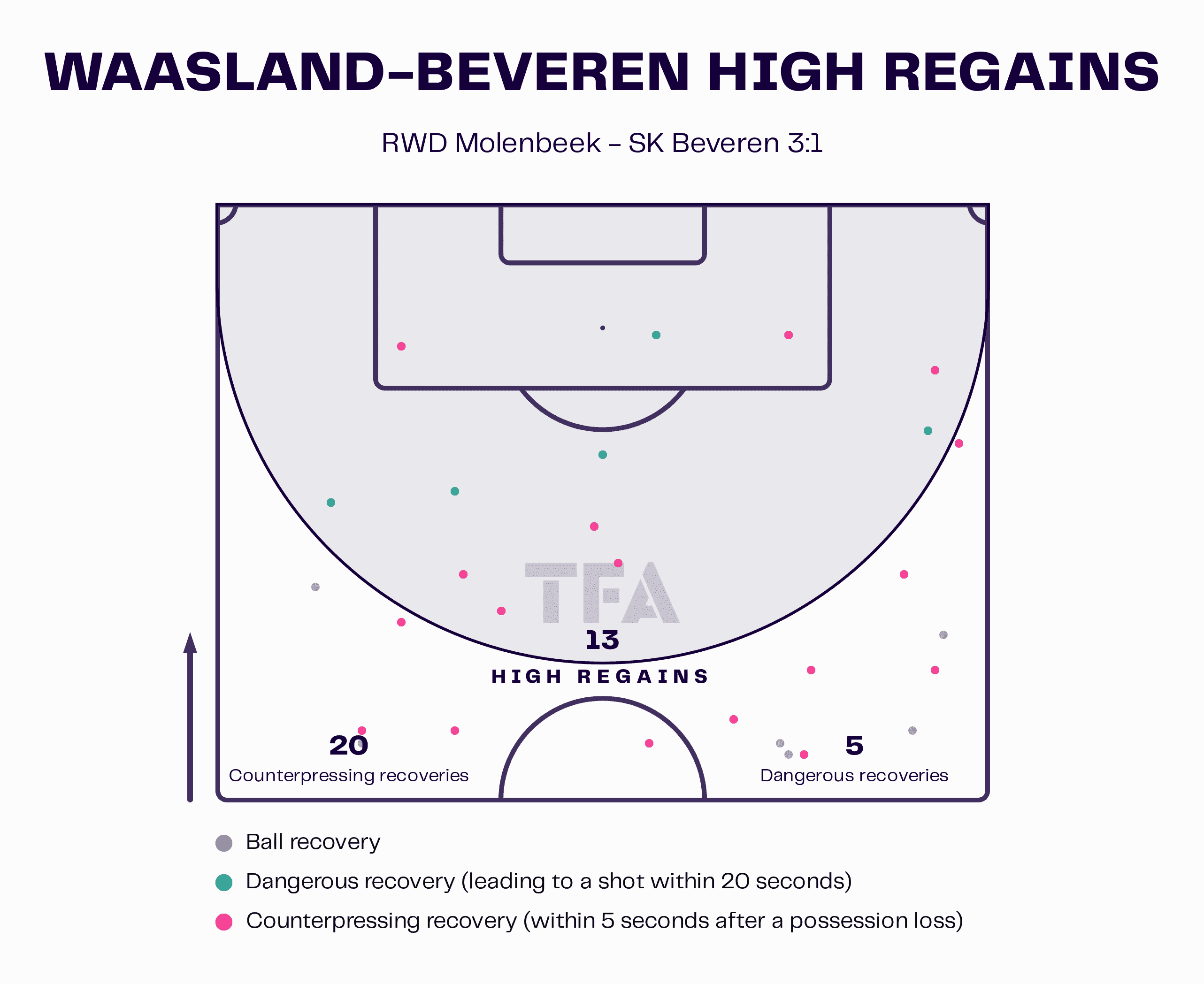
The data viz above shows the high regains that S.K. Beveren had in one of their last few matches against RWD Molenbeek. As the data viz illustrates, the Belgian side had 16 high regains, with 27 counterpressing recoveries and 7 dangerous recoveries. This highlights the tendency for the side to only press in certain situational moments, or when they feel they have a good chance of winning back possession in an advanced area.
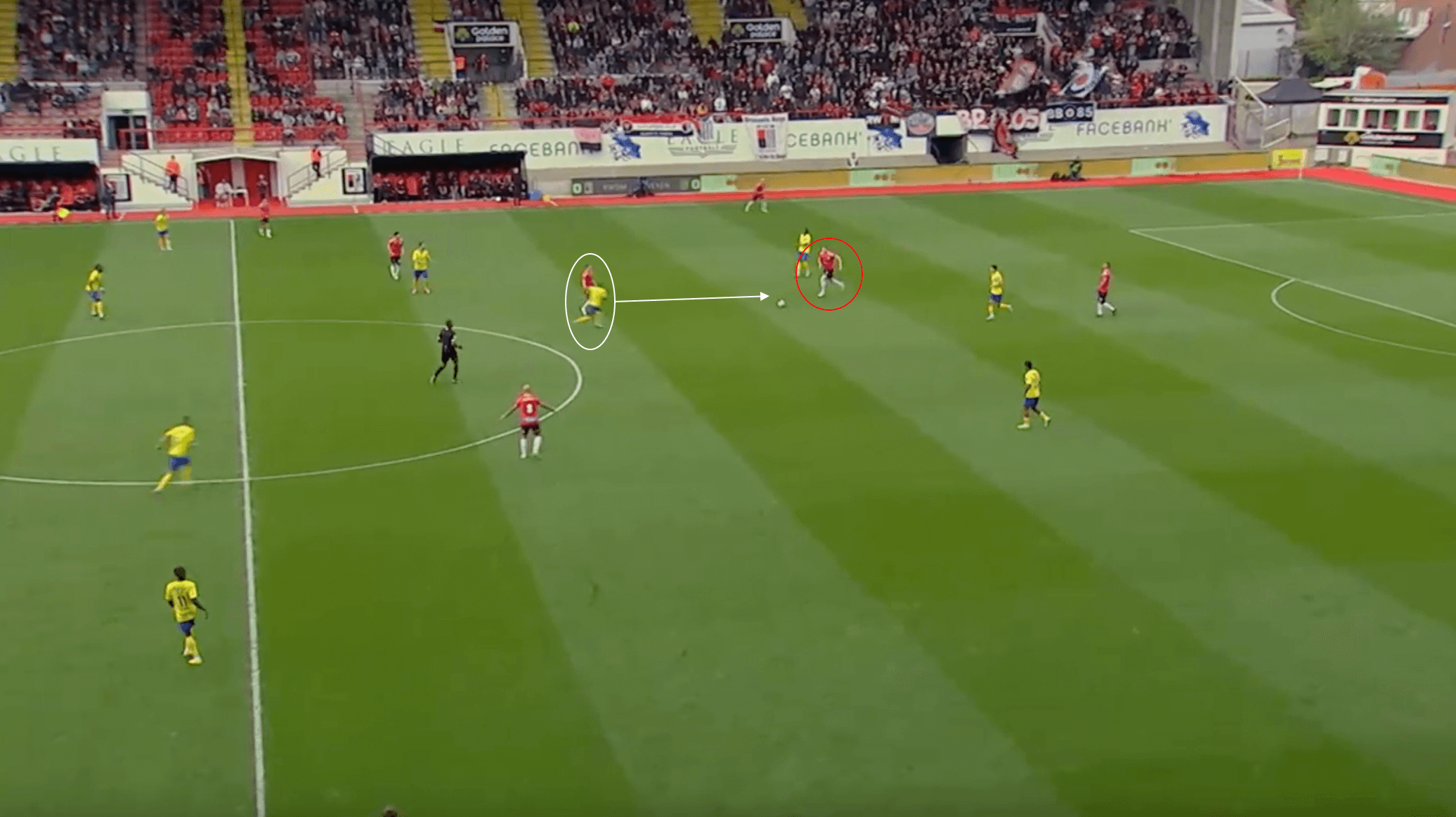
The image above shows one of these strategic pressing moments from S.K. Beveren from their recent match against Molenbeek. In this phase of play, the forward line did not put any pressure on the centre-back for Molenbeek, as he was allowed to drive forward and into the midfield. However, the defender takes a heavy touch as he is driving into midfield, which activates the press of the midfielder from Beveren, who notices this as an opportunity to step up to possibly win back possession in an advanced area.
The defender can get to the ball first, but due to the pressure of the midfielder, his ensuing pass is poor, and sent right to the Beveren defenders. As a result, they can quickly counter and form a good attacking move as a result.
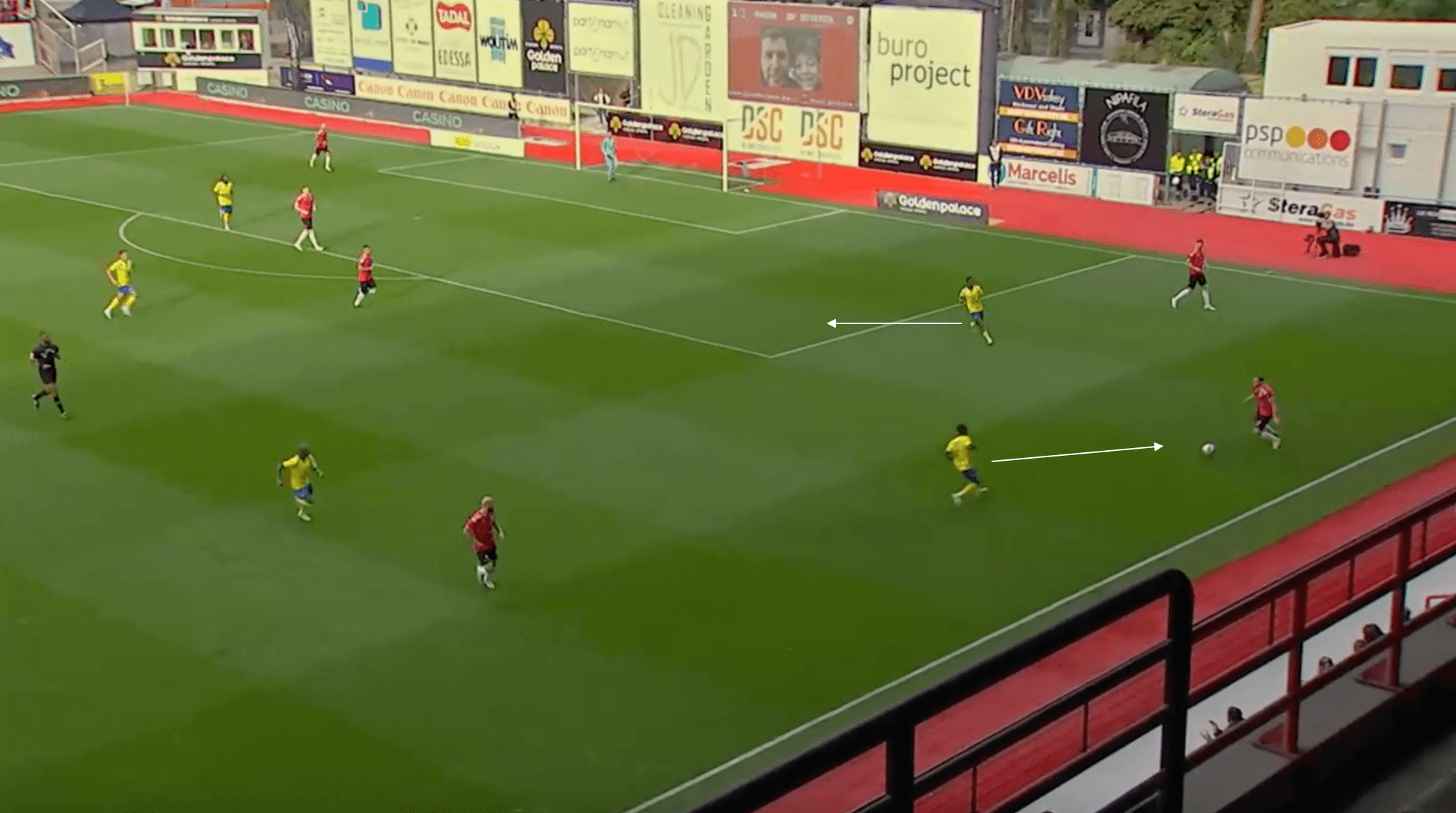
The image above shows another example of the strategic pressing from Beveren. After a goal kick from Molenbeek, they tried to play out from the back. This activated a pressing trigger for the Beveren forwards, who looked to engage. As the ball is played out to the fullback, he takes a heavy touch, which allows the forward from Beveren to close down and win possession back.
He can play the ensuing pass to the forward who has dropped off the shoulder of the defender, with him having plenty of time and space to take a shot. Unfortunately, the shot is saved by the goalkeeper, but once again illustrates the pressure that leads to this. While the pressing system of Beveren is not the same as Liverpool or Leeds United, it is still able to create chances because of the strategic nature of this pressing style.
Conclusion
As this scout report and tactical analysis has shown, Wim de Decker’s S.K. Beveren are one of the favourites to get automatic promotion to the Belgian Pro League next season. While it will not be easy, they will need to keep this pace up for the second half of the season, with Molenbeek level on points with them at the top of the table. While it may not be a Manchester City-Liverpool title race, it looks likely that it may come down to the final day to see who gets that coveted automatic promotion spot.

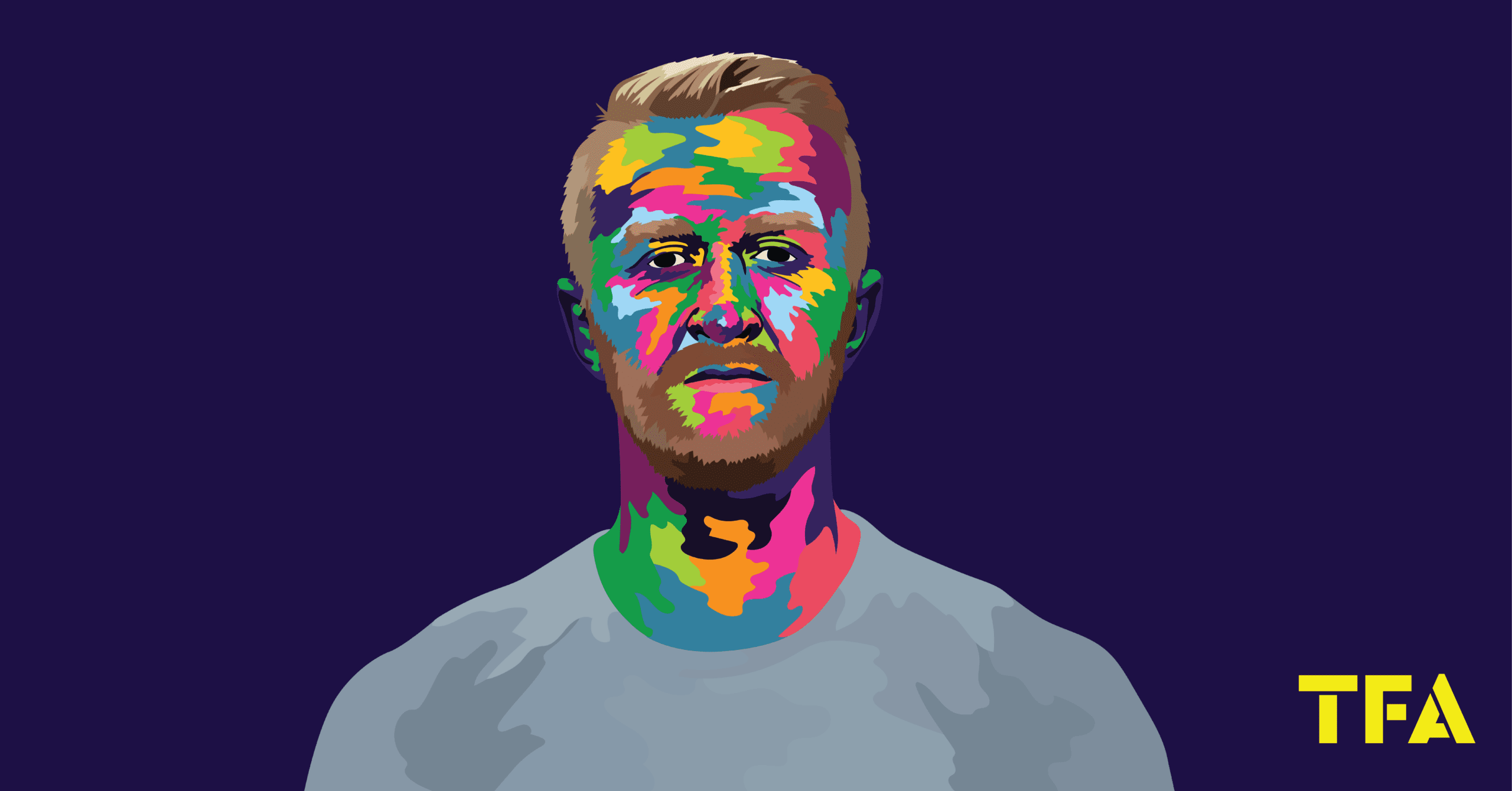

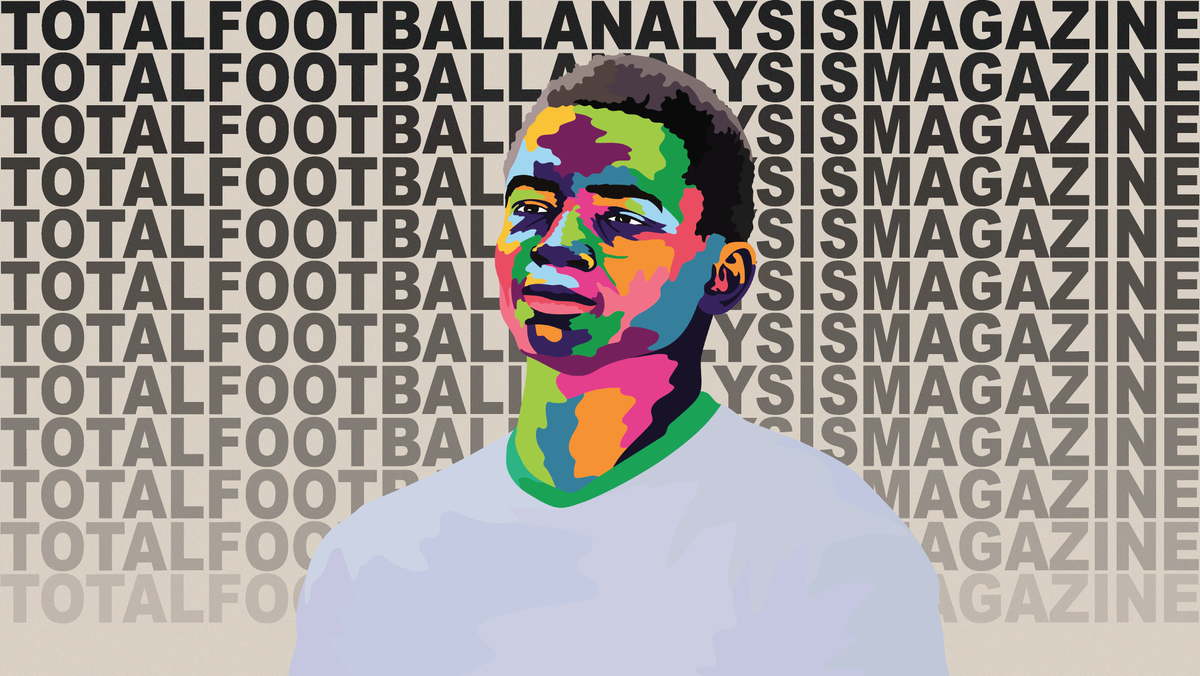

Comments